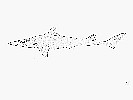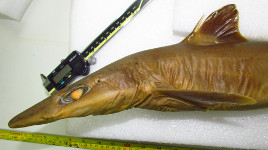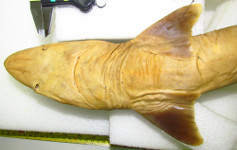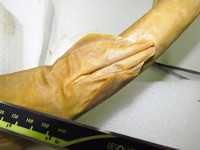Squalus melanurus
Fourmanoir, 1979
Blacktailed spurdog
Classification: Elasmobranchii Squaliformes Squalidae
Reference of the original description
Requins de Nouvelle-Calédonie – Nouvelles espèces de requins trouvées en Nouvelle-Calédonie. Nature calédonienne. 16: 11-14
Requins de Nouvelle-Calédonie – Nouvelles espèces de requins trouvées en Nouvelle-Calédonie. Nature calédonienne. 16: 11-14
Image of the original description
Image in copyright.
Image in copyright.
Synonyms / new combinations and misspellings
Squalus rancureli
Squalus rancureli
Types
Squalus melanurus
Holotype: MNHN: 1980-0460;
Squalus rancureli
Holotype: MNHN: 1978-0693; Paratype: MNHN: ? (ex ORSTOM-Nouméa)
Squalus melanurus
Holotype: MNHN: 1980-0460;
Squalus rancureli
Holotype: MNHN: 1978-0693; Paratype: MNHN: ? (ex ORSTOM-Nouméa)
Description :
Citation: Squalus melanurus Fourmanoir, 1979: In: Database of modern sharks, rays and chimaeras, www.shark-references.com, World Wide Web electronic publication, Version 12/2025
Please send your images of "Squalus melanurus" to info@shark-references.com

Squalus melanurus Fourmanoir, 1979, MNHN 1997 3625, adult male, 645 mm TL © Sarah Viana

Squalus melanurus Fourmanoir, 1979, MNHN 1997 3625, adult male, 645 mm TL © Sarah Viana
Common names
 Galludo cola negra,
Galludo cola negra,  Aiguillat à queue noire,
Aiguillat à queue noire,  Blacktail spurdog,
Blacktail spurdog,  Blacktailed spurdog
Blacktailed spurdog
 Galludo cola negra,
Galludo cola negra,  Aiguillat à queue noire,
Aiguillat à queue noire,  Blacktail spurdog,
Blacktail spurdog,  Blacktailed spurdog
Blacktailed spurdog
Short Description
Diagnosis after VIANA & DE CARVALHO, 2018 [26261]: Squalus melanurus is distinguished from all its congeners by: body conspicuously slender; conspicuous black caudal-fin lower lobe; snout obtuse and markedly elongate, its preorbital length 9.6% (10.0-10.9%) TL; more elongate distance from nostrils to tip of snout, comprising 6.9% (7.2-8.4%) TL; larger preoral length, corresponding to 12.6% (12.7-14.3%) TL; more elongate distance from spiracle to tip of snout, its length 14.7% (15.3-16.8%) TL. It is further distinct from its congeners by having broader internarial space, its width 5.1% (5.1-6.1%) TL, and more elongate second dorsal-fin spine, its length 6.2% (4.9-6.5%) TL. Squalus melanurus also differs from congeners by monospondylous vertebrae 41-41 (vs 49 for S. bucephalus vs 45-46 for S. mitsukurii vs 43-46 for S. chloroculus vs 45-47 for S. griffini vs 36-39 for S. nasutus), precaudal 85-94 (vs 78-83 for S. nasutus), and total vertebrae 114-120 (vs 124 for S. bucephalus vs 103-109 for S. nasutus).
Diagnosis after VIANA & DE CARVALHO, 2018 [26261]: Squalus melanurus is distinguished from all its congeners by: body conspicuously slender; conspicuous black caudal-fin lower lobe; snout obtuse and markedly elongate, its preorbital length 9.6% (10.0-10.9%) TL; more elongate distance from nostrils to tip of snout, comprising 6.9% (7.2-8.4%) TL; larger preoral length, corresponding to 12.6% (12.7-14.3%) TL; more elongate distance from spiracle to tip of snout, its length 14.7% (15.3-16.8%) TL. It is further distinct from its congeners by having broader internarial space, its width 5.1% (5.1-6.1%) TL, and more elongate second dorsal-fin spine, its length 6.2% (4.9-6.5%) TL. Squalus melanurus also differs from congeners by monospondylous vertebrae 41-41 (vs 49 for S. bucephalus vs 45-46 for S. mitsukurii vs 43-46 for S. chloroculus vs 45-47 for S. griffini vs 36-39 for S. nasutus), precaudal 85-94 (vs 78-83 for S. nasutus), and total vertebrae 114-120 (vs 124 for S. bucephalus vs 103-109 for S. nasutus).
Distribution
Southwestern Pacific Ocean, surrounding waters from New Caledonia, Vanuatu, and Norfolk Island (Australia) [26261] Source: www.gbif.org
Southwestern Pacific Ocean, surrounding waters from New Caledonia, Vanuatu, and Norfolk Island (Australia) [26261] Source: www.gbif.org
Human uses
fisheries: of no interest
fisheries: of no interest
Biology
Found on the insular slopes. Feeds on lanternfishes, boarfishes, barracudinas, and flatheads.
Found on the insular slopes. Feeds on lanternfishes, boarfishes, barracudinas, and flatheads.
Size / Weight / Age
75 cm TL (female)
75 cm TL (female)
Dentition
Teeth unicuspid and similar in both jaws; upper teeth smaller than lower teeth; mesial cutting edge convex; mesial heel notched on upper teeth and weakly notched on lower teeth; distal heel rounded; cusp short and thick, pointed obliquely; apron very short and heavy, placed at midline of the crown base. Three series of functional teeth on upper jaw and two series on lower jaw in holotype. Upper teeth rows 13-1-13; lower teeth rows 11-1-11 [26261]
Teeth unicuspid and similar in both jaws; upper teeth smaller than lower teeth; mesial cutting edge convex; mesial heel notched on upper teeth and weakly notched on lower teeth; distal heel rounded; cusp short and thick, pointed obliquely; apron very short and heavy, placed at midline of the crown base. Three series of functional teeth on upper jaw and two series on lower jaw in holotype. Upper teeth rows 13-1-13; lower teeth rows 11-1-11 [26261]
Remarks
shark-references Species-ID=6792;
shark-references Species-ID=6792;
Parasites (arranged by Jürgen Pollerspöck)
Monogenea
Cestoda
Copepoda
Isopoda
Monogenea
- Triloculotrema chisholmae Justine, 2009 [7422]
Cestoda
Copepoda
- Pseudopandarus cairae Bernot & Boxshall, 2017 [25052]
Isopoda
- Aega angustata Whitelegge, 1901 [16094]






















